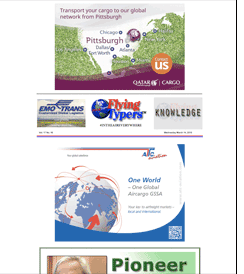
The requirement for faster, lighter shipments as global
e-commerce booms is the leading structural trend now benefiting air
cargo growth, according to a leading analyst.
In an insightful webinar organized by
Stifel in March, Brian Clancy, the cofounder and managing director of
specialist advisory Logistics Capital & Strategy (LogCapStrat) also
deciphered exactly how and why the air freight sector has bounced-back
across trade lanes, a trend he admitted had caught analysts by surprise.
But while he said there was cause for
optimism about further demand growth to come, he also warned stakeholders
- from shippers to carriers, forwarders to handlers - that the nature
of ‘etail’ demand was transformational, and meeting its
requirements would mean a rapid change of focus and business practice.
Death Reports Exaggerated
“Back in 2014–2015 it was
almost as if we were writing the obituary for the air cargo industry
because trade in general was not that robust, but in particular international
air trade was volatile and really wasn’t growing that fast,”
he said. “And what’s interesting is that, obviously it was
a tale of two cities. Whereas the express market - internationally as
well as domestically - grew very nicely over the last five or six years,
the traditional airfreight industry, which the freight forwarders are
the main participants in, obviously was struggling.
 |
The Mouse That Roared
“And then the market came roaring
back last year.”
Looking primarily at the U.S. market,
he said U.S. GDP grew “nicely” last year, but air trade
weight grew at 2.3 times GDP on the import side at 9.3%, while e-commerce
grew even faster than GDP at 12.6%.
“These are very important demand
drivers for U.S. import traffic as well as U.S. domestic,” he
added. “The Asia inbound Transpac market did extremely well at
12.2% volume growth, 3.1 times GDP. Europe was even faster. It was highly
sensitive to the rebound in the market at 3.4 times GDP, basically growing
at almost 14% for the year.
“So the point here is that the U.S.
economy came back very nicely last year. A lot of optimism in addition
to depleted inventory levels created a fantastic year from an air freight
perspective.”
Closely Watched Planes
Delving more deeply into 2017, LogCapStrat’s
research revealed that intra-North America volumes increased by 5% in
2017 primarily due to e-commerce growth and increased industrial production,
with integrators including DHL, FedEx, Amazon, UPS and their respective
ACMI partners accounting for over half of all capacity in the market.
By contrast, mixed fleet carriers operating
belly and freight capacity dominated the Transpacific market where demand
growth outpaced supply growth, resulting in improved load factors and
rising air freight rates. The Transatlantic market was different, said
Clancy, with belly capacity the largest source of supply in 2017, and
volumes growing much faster than supply, bumping up load factors and
prices.
Airports Apoppin’
Clancy also noted that, except for Detroit
and Miami, all major airport gateways in the U.S. enjoyed “robust”
import growth and increased exports last year. “Chicago continues
to be the primary distribution node in the U.S. , both in terms of its
size and its robust growth rate,” he said. “You
can see the inbound grew a solid 21% mainly driven by Asia imports but
also historically it’s also been a very important European import
market. But the flipside is the export market grew quite nicely - Chicago
continues to benefit from the industrial geography of the Midwest where
you got a lot of your industrial manufacturers and industrial material
suppliers are in the market.”
Cyclically Speaking
Clancy characterized the market last year
and into 2018 as one enjoying a better than solid recovery.
“I think the big question is whether
this is simply a synchronized cyclical uptick or is there also some
structural demand changes in play here,” he asked.
“The answer is it’s some combination
of the two.
“And I think that our current conclusions
is that about two thirds of what we saw in terms of activity in 2017
could be attributed to sort of a cyclical upturn, a synchronized cyclical
upturn.
“Then there’s another third
component that we think is buried in the market that’s related
to structural change, in particular the increased use of airfreight
as a result of e-commerce.”
Driving The Air Cargo Renaissance
Clancy outlined how structural change
in retail supply chains was creating an air cargo growth renaissance
due to cross-border e-commerce. Manufacturers with long supply chains
are shifting to online product sales fulfilled by Amazon or other online
retailers, while suppliers are using air modes because they must meet
the short cycle times required for online fulfillment
“Manufacturers send weekly palletized
shipments to online fulfillment centers by air,” he explained.
“Previously, origin-consolidated full container loads would travel
for weeks on multi-modal supply chains before reaching a distribution
center,” he said. “The shift to air mode has the following
effects - less ocean freight, less origin vendor consolidation, increased
‘customer urgency’, for example, instant-fulfillment and
gratification and lower shipment sizes.
“As e-commerce continues to gain
a material share in retail sales, additional online retail demand will
develop.”
E-Commerce Driver
He also noted that although U.S. GDP forecasts
covering 2018-22 would be substantially out-performed by Asian countries,
U.S. e-commerce growth would continue to expand at a far faster rate
that GDP. Indeed, he said in USD billions, e-commerce growth would expand
by a CAGR of 13.1% over 2012-22. This meant that the value of the market
in just a generation had increased from $182bn in 2012, to $351bn last
year and would surpass $600bn by 2022.
This will be one of the key drivers of
U.S. trade growth, which he forecast would expand by an average of 6%
over the next five years.
Direct To Consumer
Looking ahead to 2022, he said a number
of factors would impact air cargo supply, not least manufacturers selling
direct to consumers, often via service such as Amazon which had very
different fulfilment and supply requirements than traditional retailers,
as well as customers with much more demand expectations.
“So as this scenario plays out it
becomes a nice structural tailwind in the retail part of the international
trade market, and we think that intercontinentally this is going to
be a huge source of growth not only for the integrators, because they
are already experiencing that today, but freight forwarders who actually
have a capability to solve this problem, as well as the airlines, whether
they be value capacity providers or freighter operators that are in
these routes.
“We think that is absolutely has
the potential to be very transformative going forward. And then maybe
5-6 years from now there will be a B2B industrial version of this. And
that will basically provide a phase two in terms of structural shift
in the market.”
From Pallet To Parcels
“For most stakeholders,” Clancy
said,” this will essentially mean shipments moving from pallet
to parcels as market share shifts from retail to e-tail.
“Demand density will decline as
shipments will be B2C, daily volumes will often spike due to digital-enabled
unscheduled promotions, and shippers will insist on special handling
for cold chain, perishable and healthcare products.
“On the supply side, it will mean
more freighters will be needed to handle low-density parcel volumes.
More sophisticated handling for parcels will also be required at hubs
as shippers migrate away from using containers, network changes will
be needed to bring freight closer to destinations, and customers will
demand real-time tracking as a matter of course.
“The upshot of these restructures
to demand and supply will be pricing increases due to rising load factors
and limited supply growth for those in the supply chain able to adjust
to the new normal.
“Pricing will also become more surgical
– there will be less use of seasons – and truckload costs
and work rules will reduce the effectiveness and reach of some U.S.
gateways,” concluded Clancy.
SkyKing





